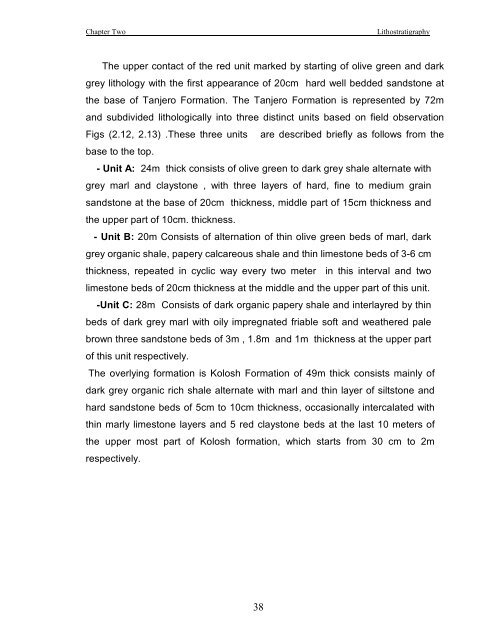biostratigraphy and paleoecology of cretaceous/tertiary boundary in ...
biostratigraphy and paleoecology of cretaceous/tertiary boundary in ...
biostratigraphy and paleoecology of cretaceous/tertiary boundary in ...
You also want an ePaper? Increase the reach of your titles
YUMPU automatically turns print PDFs into web optimized ePapers that Google loves.
Chapter Two<br />
Lithostratigraphy<br />
The upper contact <strong>of</strong> the red unit marked by start<strong>in</strong>g <strong>of</strong> olive green <strong>and</strong> dark<br />
grey lithology with the first appearance <strong>of</strong> 20cm hard well bedded s<strong>and</strong>stone at<br />
the base <strong>of</strong> Tanjero Formation. The Tanjero Formation is represented by 72m<br />
<strong>and</strong> subdivided lithologically <strong>in</strong>to three dist<strong>in</strong>ct units based on field observation<br />
Figs (2.12, 2.13) .These three units are described briefly as follows from the<br />
base to the top.<br />
- Unit A: 24m thick consists <strong>of</strong> olive green to dark grey shale alternate with<br />
grey marl <strong>and</strong> claystone , with three layers <strong>of</strong> hard, f<strong>in</strong>e to medium gra<strong>in</strong><br />
s<strong>and</strong>stone at the base <strong>of</strong> 20cm thickness, middle part <strong>of</strong> 15cm thickness <strong>and</strong><br />
the upper part <strong>of</strong> 10cm. thickness.<br />
- Unit B: 20m Consists <strong>of</strong> alternation <strong>of</strong> th<strong>in</strong> olive green beds <strong>of</strong> marl, dark<br />
grey organic shale, papery calcareous shale <strong>and</strong> th<strong>in</strong> limestone beds <strong>of</strong> 3-6 cm<br />
thickness, repeated <strong>in</strong> cyclic way every two meter <strong>in</strong> this <strong>in</strong>terval <strong>and</strong> two<br />
limestone beds <strong>of</strong> 20cm thickness at the middle <strong>and</strong> the upper part <strong>of</strong> this unit.<br />
-Unit C: 28m Consists <strong>of</strong> dark organic papery shale <strong>and</strong> <strong>in</strong>terlayred by th<strong>in</strong><br />
beds <strong>of</strong> dark grey marl with oily impregnated friable s<strong>of</strong>t <strong>and</strong> weathered pale<br />
brown three s<strong>and</strong>stone beds <strong>of</strong> 3m , 1.8m <strong>and</strong> 1m thickness at the upper part<br />
<strong>of</strong> this unit respectively.<br />
The overly<strong>in</strong>g formation is Kolosh Formation <strong>of</strong> 49m thick consists ma<strong>in</strong>ly <strong>of</strong><br />
dark grey organic rich shale alternate with marl <strong>and</strong> th<strong>in</strong> layer <strong>of</strong> siltstone <strong>and</strong><br />
hard s<strong>and</strong>stone beds <strong>of</strong> 5cm to 10cm thickness, occasionally <strong>in</strong>tercalated with<br />
th<strong>in</strong> marly limestone layers <strong>and</strong> 5 red claystone beds at the last 10 meters <strong>of</strong><br />
the upper most part <strong>of</strong> Kolosh formation, which starts from 30 cm to 2m<br />
respectively.<br />
38

















